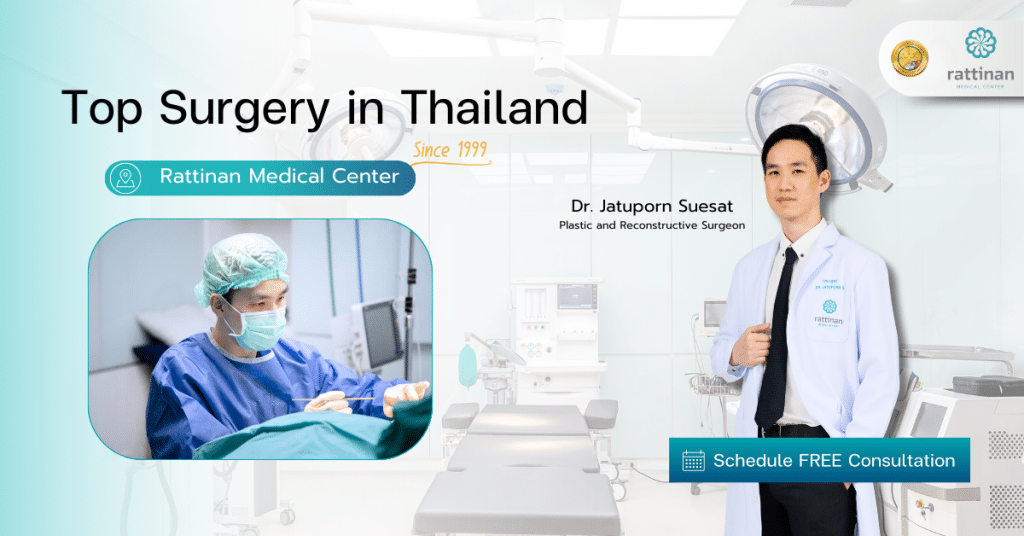At Rattinan Medical Center, we provide safe and effective gender-affirming mastectomy (top surgery) for transgender men and non-binary individuals seeking chest masculinization. Our expert surgeons offer personalized surgical techniques to help patients achieve a flat, masculine chest with natural-looking results.
Book Free Consultation
1. Key Methods of Gender-Affirming Mastectomy
Our surgeons at Rattinan Medical Center offer different top surgery techniques based on chest size, skin elasticity, and desired outcome:
- Minimally Invasive Subcutaneous Surgery – Ideal for small chests, involves small incisions and preserves nipple sensation.
- Double Incision with Nipple Grafting – The most common method for moderate-to-large chests, providing a flat, masculine contour.
Periareolar (Keyhole) Surgery – Best for small chests with tight skin, leaves minimal scarring around the areola.
2. Understanding Incision Types and Scarring
Different incision types are used based on chest size and skin condition:
- Double-Incision (T-Shaped or Straight Scar) – Suitable for large chests, provides the most masculine contour but removes nipple sensation.
- Periareolar (Circular Scar) Technique – Leaves a small scar around the areola, recommended for small breasts with good skin elasticity.
Keyhole (Minimal Scarring) – Uses a small incision, but is only effective for very small chests with minimal excess skin.
Areola and Nipple Reshaping in Top Surgery
After breast tissue removal, some patients choose to modify their areola and nipples for a masculine appearance.
Common Areola and Nipple Techniques
- Nipple Grafting – For large chests, nipples are resized and repositioned.
- Nipple Preservation – Maintains some nipple sensation for those eligible.
- Areola Reduction – Reduces areola size for a proportionate look.
Healing and scarring depend on individual skin types, but proper post-operative care can minimize scars.
Choosing the Best Surgical Approach for Your Chest
The ideal top surgery technique depends on:
- Chest size and skin elasticity
- Desired aesthetic outcome
- Preference for scar location and nipple sensation
Our experienced surgeons will guide you to choose the best option for your body and goals.
Liposuction as Part of Top Surgery
In some cases, liposuction is used to refine chest contours and improve results.
When is Chest Liposuction Needed?
- For soft breast tissue that liposuction can remove
- To refine the chest’s shape and symmetry
This step helps create a natural, defined chest appearance.
Preparing for Your Top Surgery
To ensure a safe and smooth recovery, follow these pre-surgery guidelines:
Before Surgery
- Stop smoking and alcohol at least two weeks before surgery to reduce healing risks.
- Avoid supplements and medications that thin the blood (such as aspirin, ibuprofen).
- Eat a balanced diet to boost your immune system before surgery.
Stay hydrated but limit fluids before surgery as instructed.
What to Expect During and After Surgery
The Day of Surgery
- Procedure Time: 2–4 hours
- Anesthesia: General anesthesia
- Hospital Stay: Same-day discharge or one-night stay
Post-Surgery Healing Timeline
- Week 1: Rest and wear a compression binder
- Week 2–4: Stitches removed, resume light activities
- Month 2–3: Most swelling fades, chest shape settles
Month 6–12: Final results, scars start fading
Frequently Asked Questions About Top Surgery
It depends on the technique used. Keyhole and periareolar surgeries have a higher chance of preserving sensation, while double-incision with grafting typically results in permanent loss of sensation.
No, binders do not reduce breast size but can flatten the chest temporarily. They help patients feel comfortable while waiting for surgery.
Top surgery is for transgender individuals seeking chest masculinization, while gynecomastia surgery treats excess breast tissue in cisgender men due to hormonal imbalances.
Take the Next Step Toward Chest Masculinization
At Rattinan Medical Center, we are committed to providing life-changing gender-affirming surgeries in a safe, professional, and supportive environment.
Contact us today to schedule a consultation and start your journey to a confident, masculine chest.


Our Expert Medical Contributors are licensed doctors and specialists who ensure every article is accurate, trustworthy, and easy to understand. Guided by our commitment to safety, care, and confidence, they provide expert insights to help patients make informed decisions. At Rattinan, we believe that knowledge is the first step to transformation.